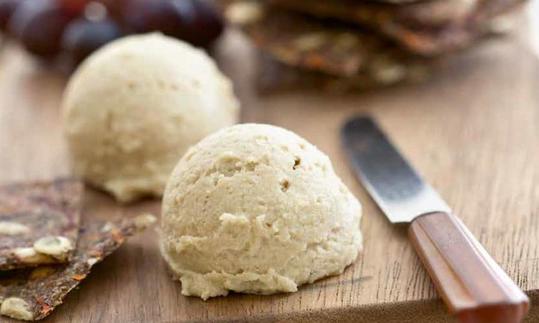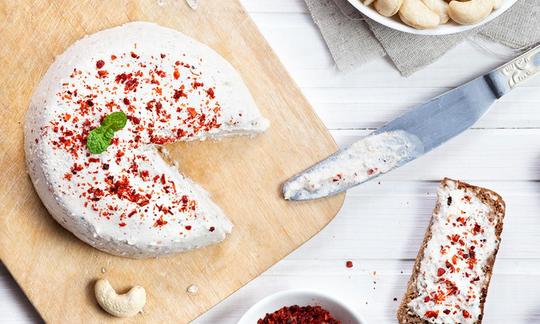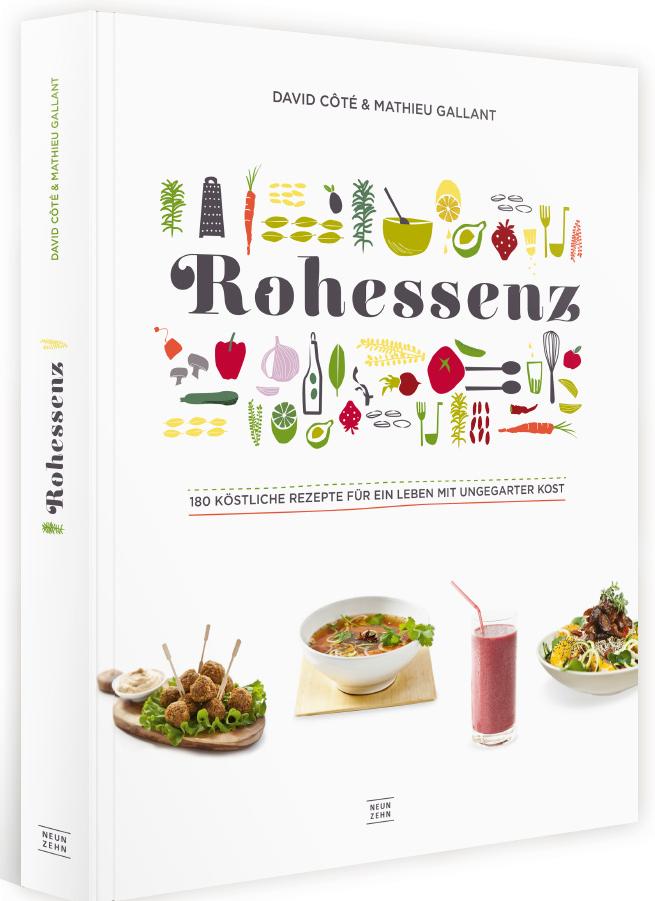Cashew "Cheese" with Miso and Coconut Oil
vegan
Ingredients (for servings, )
| For the cashew “cheese” base | |
|---|---|
| 11 oz | Cashew nuts, raw? organic? (cashew nuts) |
| 175 ml | Drinking water, raw (organic?) (6.2 oz) |
| 1 ½ tbsp | Miso (soybean paste) (0.90 oz) |
| Seasoning after fermentation | |
| 1 ½ tsp | Coconut oil (coconut oil, coconut fat, organic?, raw?) (0.24 oz) |
| 1 tbsp | Lemon juice (raw?, organic?) (0.26 oz) |
| ¼ tsp | Sea salt (raw?, organic?) (0.04 oz) |
Equipment
- blender or hand-held blender / immersion blender
Type of preparation
- soak
- melt
- purée
- ferment
Preparation
For the cashew “cheese” base
First soak the cashews. To do this, place the nuts in a bowl, cover with water, and let rest for 4 hours. Then rinse well and discard the soaking water.Cashews are a fairly soft type of nut and, if needed, you can skip or shorten the soaking step. Soaking improves the nutritional value and ensures that the sauce or dish you are making will have a better consistency.
Place the cashews, water, and miso paste in a blender. Purée until a creamy mixture forms and no cashew pieces remain.
It works best to use a high-powered blender.
Fermentation
Transfer the mixture to a bowl and cover with plastic wrap so that it is airtight. The plastic wrap should be right on top of the mixture. Let the mixture ferment for 12 hours at room temperature.Fermenting is the process in which microorganisms convert organic compounds into alcohol or organic acids. In this case, fermentation takes place in the absence of oxygen and is called lactic acid fermentation. Since electron receptors (here O2) are not present, the microbes have to use other metabolic processes to break down organic substances and produce energy. This causes a change in the taste.
Seasoning after fermentation
When the fermentation process is complete, melt the coconut oil. Add the lemon juice, salt, and coconut oil to the cashew mixture. Then garnish with herbs of your choice and serve.If you are using freshly squeezed lemon juice, 1/6 of a medium-size lemon will yield about 1 tablespoon lemon juice.
|
Nutritional Information per person
Convert per 100g
|
2000 kcal | |
|---|---|---|
| Energy | 221 kcal | 11.1% |
| Fat/Lipids | 17 g | 25.0% |
| Saturated Fats | 3.6 g | 18.2% |
| Carbohydrates (inc.dietary fiber) | 12 g | 4.5% |
| Sugars | 2.4 g | 2.7% |
| Fiber | 1.4 g | 5.6% |
| Protein/Albumin | 7.2 g | 14.5% |
| Cooking Salt (Na:183.6 mg) | 466 mg | 19.4% |
| Essential micronutrients with the highest proportions | per person | 2000 kcal | |
|---|---|---|---|
| Min | Copper, Cu | 0.84 mg | 84.0% |
| Prot | Tryptophan (Trp, W) | 0.11 g | 46.0% |
| Elem | Phosphorus, P | 228 mg | 33.0% |
| Min | Manganese, Mn | 0.65 mg | 32.0% |
| Elem | Magnesium, Mg | 111 mg | 30.0% |
| Fat | Linoleic acid; LA; 18:2 omega-6 | 3.0 g | 30.0% |
| Prot | Threonine (Thr, T, irreversibly transaminated) | 0.27 g | 29.0% |
| Prot | Valin (Val, V) | 0.43 g | 27.0% |
| Prot | Isoleucine (Ile, I) | 0.31 g | 25.0% |
| Prot | Leucine (Leu, L) | 0.58 g | 24.0% |
Detailed Nutritional Information per Person for this Recipe
The majority of the nutritional information comes from the USDA (US Department of Agriculture). This means that the information for natural products is often incomplete or only given within broader categories, whereas in most cases products made from these have more complete information displayed.
If we take flaxseed, for example, the important essential amino acid ALA (omega-3) is only included in an overarching category whereas for flaxseed oil ALA is listed specifically. In time, we will be able to change this, but it will require a lot of work. An “i” appears behind ingredients that have been adjusted and an explanation appears when you hover over this symbol.
For Erb Muesli, the original calculations resulted in 48 % of the daily requirement of ALA — but with the correction, we see that the muesli actually covers >100 % of the necessary recommendation for the omega-3 fatty acid ALA. Our goal is to eventually be able to compare the nutritional value of our recipes with those that are used in conventional western lifestyles.
| Essential fatty acids | per person | 2000 kcal |
|---|---|---|
| Linoleic acid; LA; 18:2 omega-6 | 3.0 g | 30.0% |
| Alpha-Linolenic acid; ALA; 18:3 omega-3 | 0.04 g | 2.0% |
| Essential amino acids | per person | 2000 kcal |
|---|---|---|
| Tryptophan (Trp, W) | 0.11 g | 46.0% |
| Threonine (Thr, T, irreversibly transaminated) | 0.27 g | 29.0% |
| Valin (Val, V) | 0.43 g | 27.0% |
| Isoleucine (Ile, I) | 0.31 g | 25.0% |
| Leucine (Leu, L) | 0.58 g | 24.0% |
| Phenylalanine (Phe, F) | 0.37 g | 24.0% |
| Lysine (Lys, K, irreversibly transaminated) | 0.36 g | 20.0% |
| Methionine (Met, M) | 0.14 g | 15.0% |
| Vitamins | per person | 2000 kcal |
|---|---|---|
| Vitamin K | 14 µg | 18.0% |
| Vitamin B1 (Thiamine) | 0.16 mg | 15.0% |
| Vitamin B6 (pyridoxine) | 0.16 mg | 12.0% |
| Vitamin B7 (Biotin, ex vitamin H) | 4.3 µg | 9.0% |
| Vitamin B5 (Pantothenic acid) | 0.34 mg | 6.0% |
| Vitamin B9, B11 (Folate, as the active form of folic acid) | 10 µg | 5.0% |
| Vitamin B3 (Niacin) | 0.43 mg | 3.0% |
| Vitamin E, as a-TEs | 0.34 mg | 3.0% |
| Vitamin B2 (Riboflavin) | 0.03 mg | 2.0% |
| Vitamin C (ascorbic acid) | 0.54 mg | 1.0% |
| Vitamin A, as RAE | 0.13 µg | < 0.1% |
| Vitamin B12 (Cobalamin) | 0.00 µg | < 0.1% |
| Essential macroelements (macronutrients) | per person | 2000 kcal |
|---|---|---|
| Phosphorus, P | 228 mg | 33.0% |
| Magnesium, Mg | 111 mg | 30.0% |
| Sodium, Na | 184 mg | 23.0% |
| Potassium, K | 255 mg | 13.0% |
| Calcium, Ca | 16 mg | 2.0% |
| Essential trace elements (micronutrients) | per person | 2000 kcal |
|---|---|---|
| Copper, Cu | 0.84 mg | 84.0% |
| Manganese, Mn | 0.65 mg | 32.0% |
| Zinc, Zn | 2.3 mg | 23.0% |
| Iron, Fe | 2.6 mg | 19.0% |
| Selenium, Se | 7.7 µg | 14.0% |
| Iod, I (Jod, J) | 2.0 µg | 1.0% |
| Fluorine, F | 16 µg | < 0.1% |
The book "Raw Essence" offers basic raw food cooking with its own philosophy and is very well presented and informative.
Since this book is written in German, a description is omitted here. If you are interested, please switch to German in the menu.
Cashew "cheese" with miso and coconut oil is a savory fermented cashew product that is a nice replacement for dairy cheese.
We don’t consider miso to be raw. Soybeans are generally heated during the production process since green beans of all types contain the glycoprotein phasin, which is toxic for humans. Phasin inhibits the absorption of nutrients in the intestine, causes hemagglutination (clumping of the red blood cells), and in larger amounts can destroy the intestinal villi. Heating processes (e.g., cooking and roasting) destroy phasin and make soybeans and soybean products such as tofu, miso, and tempeh edible for humans. As a result, even unpasteurized soy products are not actually raw, but are instead cooked products that have been “revived” through the process of fermentation.
This information should help you understand why we label this recipe as vegan cooked food even though it is listed as raw food in the cookbook it comes from.
Fermentation: Fermenting is the process in which microorganisms convert organic compounds into alcohol or organic acids. The method presented here takes place in the absence of oxygen and is called lactic acid fermentation. The product is fermented anaerobically so that the electron receptors (here O2) are not present. This means that the microbes have to use other metabolic processes to break down organic substances and produce energy, which causes a change in the taste. These processes also generally extend or change the shelf life or storage conditions of the foods in question. This is why this type of preservation was commonly used before refrigerators had been invented.
People now eat far fewer fermented foods, especially those that have not been pasteurized (in factories). However, raw fermented products are especially important for good health — as well as a large number of enzymes and vitamins, they also contain beneficial lactic acid bacteria, which has a positive effect on our intestinal flora.
Misconceptions about vitamin B12: It is a common misconception that fermented products are a source of vitamin B12. Lacto-fermented foods, for example, sauerkraut and tempeh, contain small amounts of B12 but these are primarily inactive B12 analogs. They do have biochemical similarities, but our body cannot use or convert these analogs.
Soaking time: It is best to soak the cashews 3–4 hours (raw foodists have differing opinions here) in order to ensure a better consistency and activate the nuts. This process reduces the levels of phytic acid in nuts (and legumes), which is important because phytic acid binds to minerals in the gastrointestinal tract and as a result these cannot be metabolized. In general, cashews are relatively soft nuts and, if necessary, the soaking step can be left out or shortened. The consistency of the sauce or other recipe you make will still be smooth and creamy.
Storage: The “cheese” can be stored in an airtight container for up to 10 days in the refrigerator.
Herbs: The author recommends garnishing the cashew “cheese” with herbs such as rosemary or basil before serving.
Using leftovers: After you have made the cashew “cheese” once, you can make the recipe again using 2 tbsp of the fermented cashew “cheese” in place of the miso.






